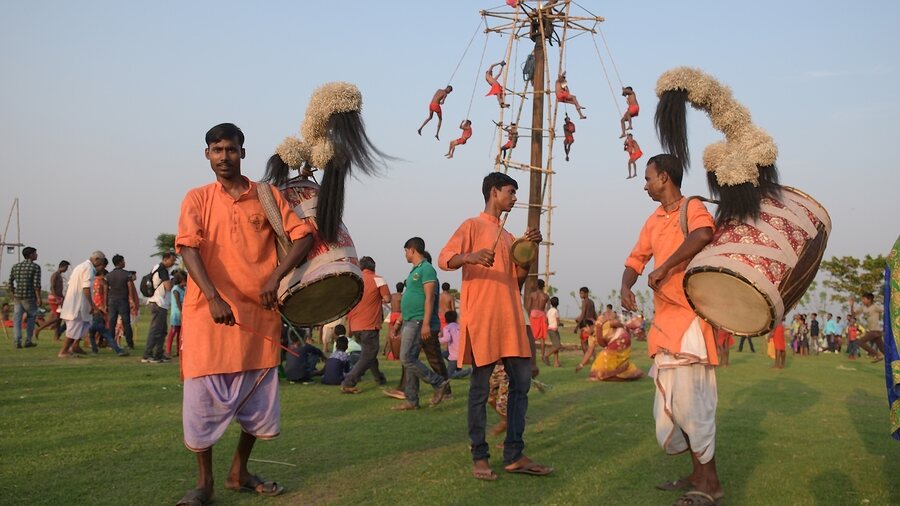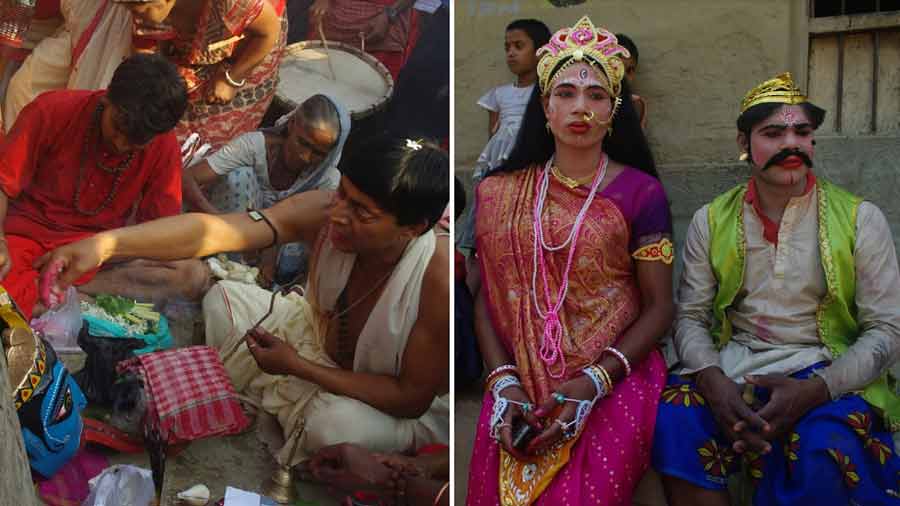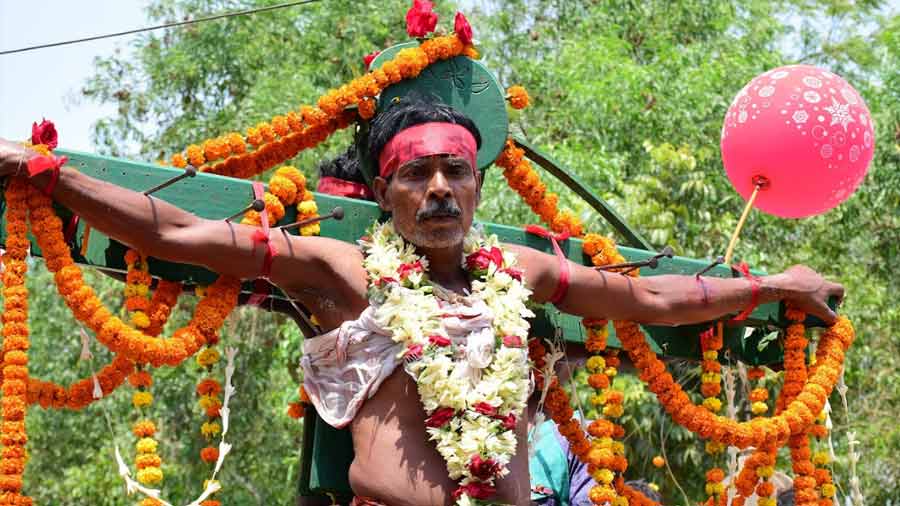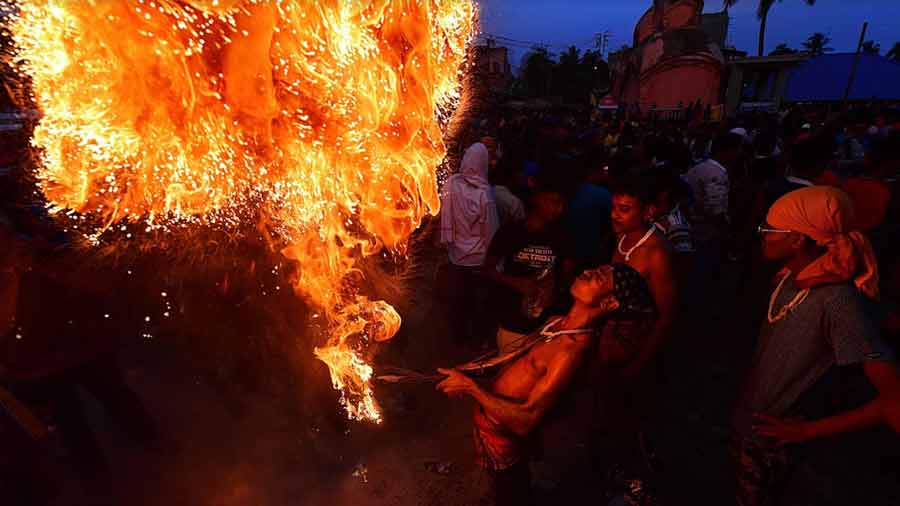Pre-colonial Kolkata, and Bengal, would witness the celebration of the Charak festival — sometimes referred to as Charak Gajan — with great pomp and show. Among early mentions of the festival is a detailed account by author and playwright Kaliprassanna Singha, who wrote under the pen name Hutom Pyancha, in his work Hutom Pyanchar Naksha.
The colourful celebrations, that involve pantomimes and daring rituals, were once popular and prevalent within Kolkata. The festival has always been known for its ‘non-elite’ nature, and is celebrated by non-Brahmin communities. In today’s time, the Charak rituals can be seen in two spots in the city — Chatu Babu Latu Babu Bazar in the north and Kalighat in the south. The festivities, occurring close to Poila Baisakh on the last two days of the month of Chaitra — around April 14 in the Gregorian calendar, usually — are now predominantly seen outside the city.

The Charak Gajan melas are usually organised on open fairground and see the participation of different communities of all nearby villages Amitabha Gupta
Charak Gajan melas are a prime feature, where people gather to celebrate all aspects of the festival.
Gajan: songs, devotion and colourful costumes

Devotees paint their faces to dress as gods and mythological characters and sing songs known as ‘Gajaner gaan’ Plabon Das, Debasish Bose
Gajan, also known as Dharmer Gajan or Shiber Gajan, brings colour and music to the Charak Gajan celebrations. The most interesting part of Gajan are the costumes. Devotees dress up as god and their consorts and sing and dance, or even perform small dance dramas related to mythological stories.
There is no definite period to which the origins of Charak or Gajan can be traced. Some historians opine that Buddhist monks, who took shelter in Bengal during a period of decline for Buddhism, converted to Hinduism and brought rituals of penance and monasticism to the fold.

The worship of Dharmathakur to pray for rain and a good harvest are also part of the Gajan festivities along with pantomimes by worshippers in costume Amitabha Gupta
Dharmer Gajan, which is celebrated on other dates as well, is linked with the worship of Dharmathakur or Dharmaraj, a gram devata or rural deity generally worshipped by agricultural and non-Brahmin communities. Often seen as the god of fertility, prayers are offered to Dharmathakur for rains and a good harvest. Since Shiva is worshipped by many farming communities as well, Shiber Gajan during Charak celebrates him.

Revellers of all ages and people of different communities join in the Gajan celebrations Amitabha Gupta, Plabon Das
The exuberant performers and devotees in costume are often called Gajan sanyasis or bohurupis, some even refer to them as shawng or jesters. The roar or garjan of the devotees accompanied by drums and trumpets is often attributed to the origin of the word Gajan. The other theory is the combination of Bengali words gna (village) and jan (people) and for a festival that brings together communities.
Gajan sanyasis, with painted faces and costumes, were often seen on Kolkata streets singing Gajaner gaan even until a few decades ago, but not so much anymore.
Charak: Daring rituals of penance

Many of the rituals involved in Charak are performed as acts of penance and are not for the weak hearted Amitabha Gupta
In an 1833 journal article written by Dewan Ramkamal Sen, secretary of the Asiatic Society, the author mentions the rituals, writing, "The word Charak is derived from Chakra or Charaka, which means a circle, and is used to signify moving or swinging in a circular direction; Charak Sanyasa implies leaving off worldly business, living abstemiously, observing austerities, for the propitiation of Siva."
Each locality has a set of rituals, some common and some different, that might be interesting to see but not are not for the weak hearted. The traditions of Charak Puja involve worshipping the charak or gajari tree and devotees piercing themselves with sharp objects like hooks or long needles as an act of penance.

The scene at a Charak fair Amitabha Gupta
In some cases, mothers bring infant children to be blessed by the sanyasis. Like with many such festivals in India and around the world, the devotees are oft-heard saying that they are in a trance when performing these acts. Many such daredevil acts — including rituals with fire, being pierced by arrows and lying on a bed of nails — are seen at the Charak Gajan melas and are part of the rituals for the festival.

Many daredevil acts — including rituals with fire — are seen at the Charak Gajan melas Sammya Brata Mullick
The acts were once seen as a way for peasants to gain the respect and favour of landlords. During the British Raj, official orders prohibited the piercing of bodies and hook swinging in public. The festival continued despite the ban, but over time the acts of self-inflicted pain reduced and the traditional public show — shawng, bohurupi or pantomime — were seen more.
Places to visit in Bengal to see the Charak Gajan festivities
- Krishnadebpur near Ambika Kalna in Burdwan
- Santipur in Nadia
- Gurudasnagar near Diamond Harbour
- Bijna village near Halisahar
- Gangatikuri village near Katwa in East Burdwan
- Bainan in Howrah
- Baruipur
- Joynagar-Majilpur
